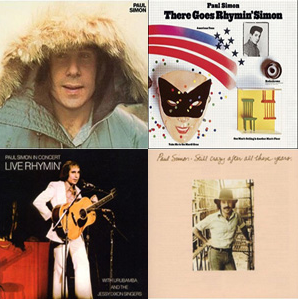It wasn’t surprising that Paul Simon went through the 70s with a string of solo hits. Splitting with his partner Art Garfunkel, the main songwriter of the team went on to see unparalleled pop and critical success, Grammys and a career that put him at the forefront of bringing world music to the masses. Luckily for us all, Legacy has reissued four of Simon’s early solo works as remastered editions with expanded packaging plus bonus tracks.
Starting with what is actually his second solo release, but first after splitting with Garfunkel in 1970, the eponymous Paul Simon, released in 1972, features the mega hit, “Me And Julio Down By The Schoolyard,” the whispery quiet “Duncan,” the wry lyrics of “Papa Hobo” and “Paranoia Blues,” and Simon’s first experiment with world music, the Top 10 single “Mother and Child Reunion” — considered by many as the first attempt by a white musician to incorporate reggae into his work. Paul Simon features bonus cuts, including demos of “Duncan” and “Me And Julio Down By the Schoolyard,” and an unreleased version of “Paranoia Blues.”
There Goes Rhymin’ Simon, Simon’s second post-Garfunkel solo effort, came a year later and considered a masterpiece of pop-folk. The lead single “Kodachrome” sounds about the best it ever has through the remaster and on this 14-song collection (the original album as 10) we get the Dixie Hummingbirds providing that perfect gospel backing vocal swing to “Loves`Me Like A Rock,” Simon’s ode to his first wife Peggy, the beautiful “Something So Right,” and his classic “American Tune.” “Was A Sunny Day” is nice, semi-reggae pop with a great lyric (nobody really writes these kind of lyrics better than Simon). “Tenderness” features a wonderful Simon vocal in a torchy 50s-like style, while the super sweet “St. Judy’s Comet” features a soft Simon vocal with some tasty electric guitar work by Pete Carr. The bonus tracks here are pretty interesting, with acoustic demos of “Take Me To The Mardi Gras” and “Loves Me Like A Rock.” There’s also “Let Me Live In Your City,” which would become “Something So Right” in its released version.
Recorded during his 1973-74 tour, Paul Simon In Concert: Live Rhymin’ is pretty much a stripped-down live album. Out of the four reissues, this is the only one they actually remastered for this round (the other three are taken from earlier remasters). Simon runs through his solo stuff like “Me And Julio Down By the Schoolyard” and “American Tune,” as well as Simon and Garfunkel classics like “Homeward Bound” (a truly beautiful version here) and “El Condor Pasa (If I Could),” featuring the mixed Argentinian/Ugandan group called Urubamba, who also play on “Duncan” and a truly inverted version of “The Boxer.” The Jessy Dixon Singers join Simon for “Mother And Child Reunion.” Then the singer “Bridge Over Troubled Water,” which is amazing, even in light of the better known version with Garfunkel on lead vocal.
Still Crazy After All These Years, released in October 1975 and produced by Paul Simon and Phil Ramone, sees a slightly darker mood, though there are deceptively poppy tunes like the title track and “5o Ways To Leave Your Lover”. This is the album Simon wrote and recorded in the wake of his divorce and the first since they broke up to feature Art Garfunkel again in Simon’s work on the reunion track, “My Little Town.” Phoebe Snow provides background vocals, and duets with Simon on the masterful “Gone at Last.”
Richard Tee and his echoey perfect Fender Rhodes flourishes, back in the day when an instrument could be recognized for such a distinctive sound. For me, this is Simon’s best solo recording of all these albums. His sensibility is of a mature songwriter, using players at the highest level of their abilities. just listen to drummer Steve Gadd at the beginning of “50 Ways.” (His playing is as startling here as it is on Steely Dan’s Aja). And how can it ever get any better than having Simon and Garfunkel reunite, especially on a song as sad and sung so well as “In My Little Town.”?
This is just the beginning of the Paul Simon catalog reissues coming from Legacy, so we’re sure to see and hear more of this wonderful music. For now, we can gobble up these four gems from the early 70s — pivotal years of Paul Simon’s life — and readily understand why Paul Simon is such a genius.
~ Ralph Greco, Jr.




















